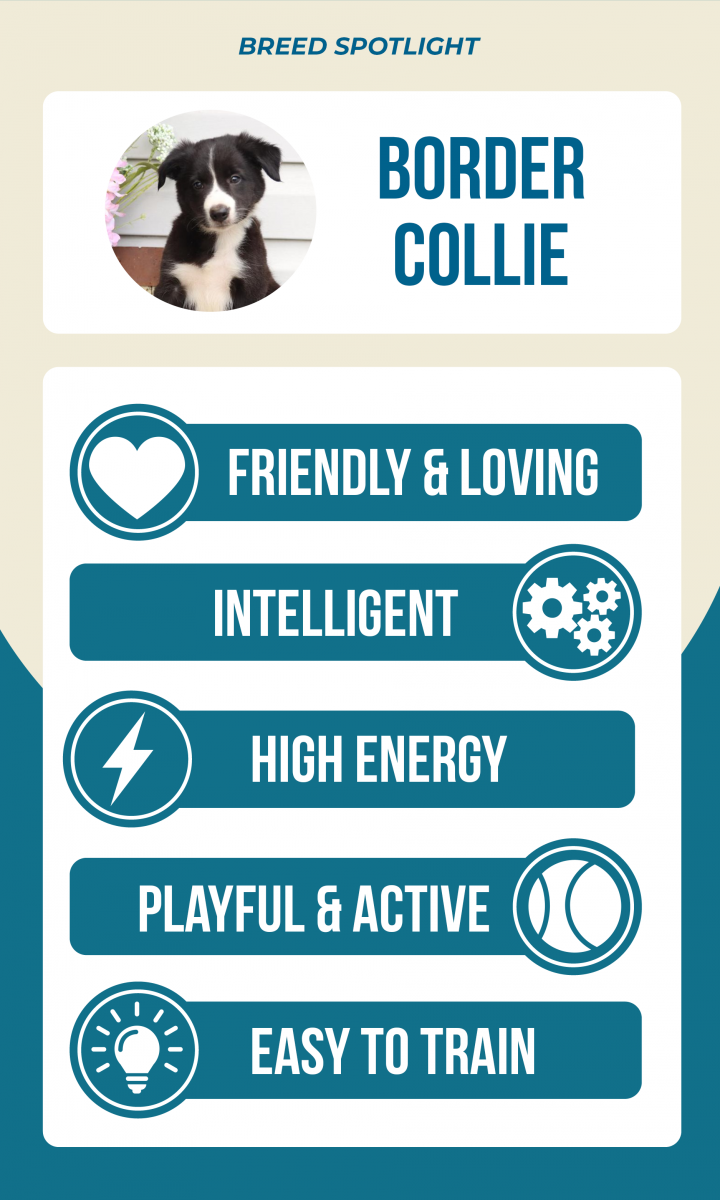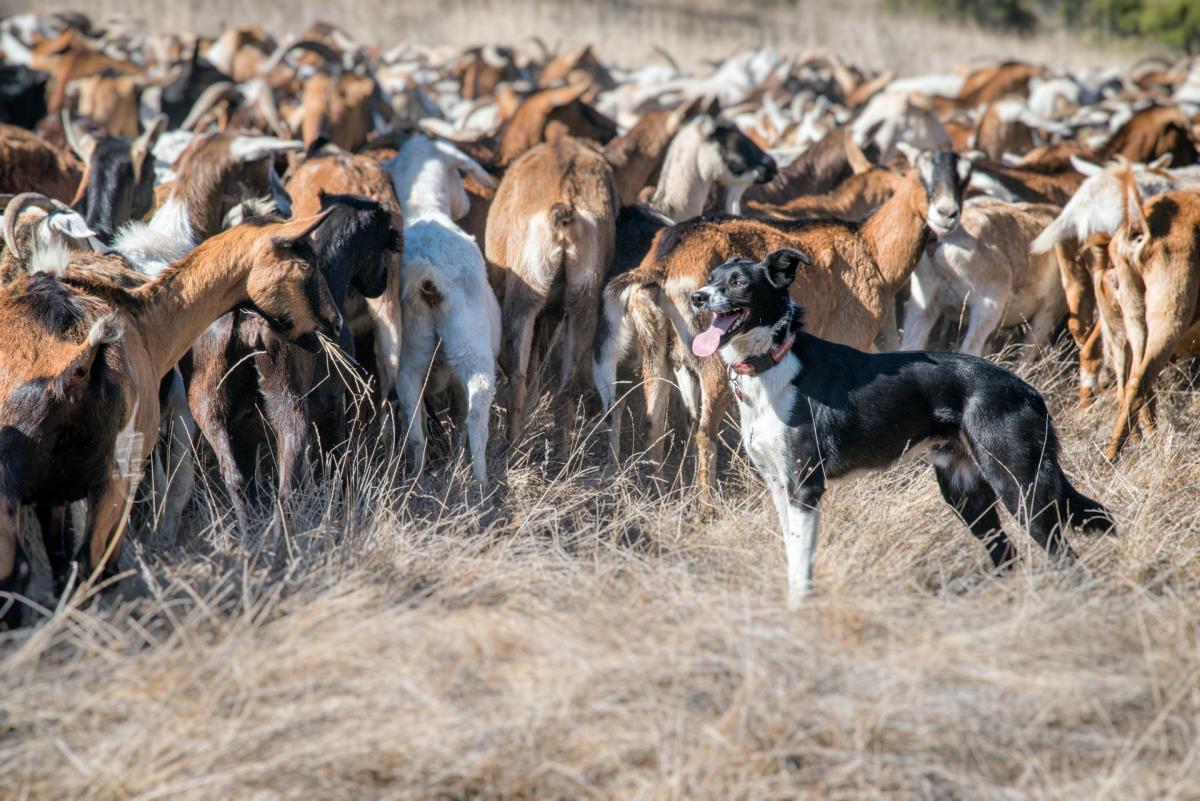Known for its intelligence and exceptional working abilities, the Border Collie is a breed like no other. If you’re looking for an active and loyal companion who will keep you on your toes, the Border Collie may be the breed for you! Keep reading to learn more about this wonderful breed.
History of the Border Collie

The Border Collie first appeared in the United Kingdom during the 1800s, where it was used as a herding dog and a guard dog, along with several other sheep herding breeds. Over time, certain kinds of these sheepdogs became preferable over others. So, to determine the superior sheepdogs, a trial was held in 1873. The standout breeds from the trial were then bred for their exceptional working abilities, which led to the creation of the Border Collie.
The Border Collie arrived in the United States during the early 1900s, and it didn’t take long for the breed to gain popularity. The Border Collie was especially popular among shepherds and farmers due to its strong obedience capabilities.
As time went on, the Border Collie’s stellar herding abilities led many to believe that the breed should only be bred as a working dog, not as a show dog. As a result, many Border Collie fans actively fought against the use of Border Collies as show dogs, for fear that it may cause a decline in the breed’s working capabilities. However, despite some pushback, the American Kennel Club (AKC) officially recognized the Border Collie in 1995.
Border Collie Characteristics
Appearance
The Border Collie is a medium-sized dog, standing about 18-22 inches tall at the withers on average. A healthy weight for a Border Collie is between 25 and 45 pounds, depending on sex.
Border Collies have a dense double coat that varies from straight to slightly curly. In terms of coat color, most Border Collies are a mix of black and white or brown and white. However, these pups can also be tricolored, brindle, merle, or single-colored.
Temperament
The Border Collie has a reputation for being one of the most intelligent dog breeds. Couple its smarts with boundless energy and remarkable agility, and you have a wonderful herding dog, a spectacular competitor, or maybe just a faithful and fun-loving companion for the outdoors.
Due to their history as sheep herding dogs, Border Collies love to work and stay busy, so it’s important to keep them on their toes. These pups love having a job to do, and they can quickly become destructive or mischievous out of boredom. That said, the Border Collie isn’t the type of dog who will lie quietly on the floor and relax while you’re watching TV or lounging around. These dogs are very energetic, and it’s essential that they receive plenty of exercise and mental stimulation daily.
When it comes to friendliness, Border Collies are a bit on the shy side. However, when properly socialized, these dogs have little difficulty getting along with other people and animals.
Health

The Border Collie is generally a healthy breed, but like all dogs, it’s susceptible to certain health issues. One of these is hip dysplasia, a genetic disease characterized by a malformed hip socket. Dogs with hip dysplasia will appear normal, so the condition is diagnosed through X-ray screening. Depending on severity, treatment for hip dysplasia can range from pain medication to surgery.
Border Collies can also be affected by Collie Eye Anomaly (CEA), an inherited condition that causes abnormalities in a dog’s eyes. The severity of this condition varies, but it can lead to slight or total vision loss in some cases. While there’s no cure for CEA, it can be detected in puppies as young as 5-8 weeks, so it’s important to have your Border Collie puppy examined as early as possible.
Aside from hip dysplasia and Collie Eye Anomaly, other conditions that can occur in Border Collies are epilepsy, allergies, hypothyroidism, and Osteochondrosis Dissecans (OCD).
Caring for a Border Collie
The Breed’s Ideal Home
A Border Collie will thrive in a household that can provide it with plenty of exercise and playtime. If you’re considering adopting a Border Collie, you must be sure that you can keep up with the breed’s high energy and exercise needs, as a Border Collie that isn’t given enough mental and physical stimulation is likely to develop problematic behaviors.
Due to how active they are, Border Collies typically do best in homes where they have plenty of room to run. A large, fenced-in yard is ideal for this breed. Keep in mind that, unless you are extremely active, getting a Border Collie is not recommended if you live in an apartment.
Training Best Practices
 Training a Border Collie isn’t challenging, but it’s still important to start training the day you bring your puppy home. During puppyhood, Border Collies are able to absorb a lot of information, so it’s a key time to teach them some essential obedience skills and commands. Before anything else, though, it’s essential that you establish leadership and dominance with a Border Collie puppy. Once they know that you’re in charge, they will follow rules willingly.
Training a Border Collie isn’t challenging, but it’s still important to start training the day you bring your puppy home. During puppyhood, Border Collies are able to absorb a lot of information, so it’s a key time to teach them some essential obedience skills and commands. Before anything else, though, it’s essential that you establish leadership and dominance with a Border Collie puppy. Once they know that you’re in charge, they will follow rules willingly.
One of the first places to start when training a Border Collie is with potty training. Take your puppy outside frequently; about once an hour. Even if they don’t go potty every time, it’s valuable to establish a consistent schedule and prevent any accidents in the house. When your puppy does go to the bathroom outside, be sure to praise them or give them a treat to reinforce the behavior.
Another area of Border Collie training to begin right away is socialization. Once your puppy has its shots and vaccines, start introducing them to different people, animals, and places. In order to learn how to behave around other people and animals, a Border Collie puppy must first become accustomed to being in social situations.
Exercise
As mentioned above, Border Collies require lots of daily exercise. At a minimum, this breed needs 30 to 60 minutes of physical activity every day, but preferably more. Border Collies love to run, so it’s recommended to take them to a secure area where they can run off-leash. Dog parks can be great for Border Collies, but only if they get along well with other dogs.
It’s important to note that exercise for a Border Collie doesn’t stop with physical activity. This is a smart breed that requires a good deal of mental stimulation, too. As a Border Collie owner, it’s crucial to set aside time each day to play with your dog and have training sessions. Try to focus on activities that will challenge and stimulate your Border Collie’s mind.
Grooming and Hygiene
While Border Collies do shed quite a bit, their coat does not need excessive grooming or maintenance. It is recommended that you brush your Border Collie once or twice a week to prevent their fur from matting. However, more frequent brushing will likely be necessary during shedding seasons in the spring and fall.
In terms of bathing, Border Collies only require baths on an as-needed basis. Additionally, their teeth should be brushed a few times a week to get rid of tartar and prevent bacteria buildup.
If you’ve determined that the Border Collie is the breed for you, find your new furry friend using Lancaster Puppies today!

